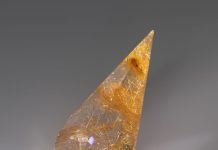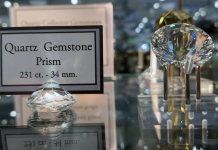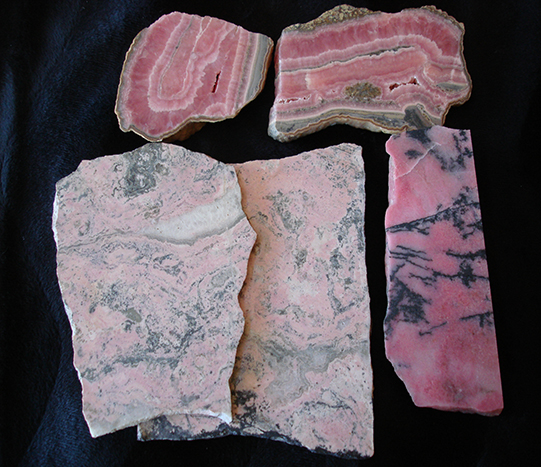
By Helen Serras-Herman
Astorite is a rare rock composed mostly of pink rhodonite, along with various amounts of quartz (mostly in the form of chalcedony), rhodochrosite, gold, silver, and other minerals.
Astorite is a trade name given to this material to honor its original mine owner, John Jacob Astor IV. The material is mined only at the historic Toltec gold mine in the San Juan Mountains of southwestern Colorado, which are part of the Rocky Mountains. The mine is located at a very remote area above 10,000 feet, about 10 miles from the town of Silverton, an area that became famous for silver and gold mining at the end of the 19th century and beginning of the 20th century.
Silverton and Ouray
The town of Silverton is located in San Juan County, at 9,318 feet elevation, in the majestic San Juan Mountains, nestled between two rugged passes, the Red Mountain and the Molas passes. Silverton’s moniker, “The Heart of the High Country”, reflects the reality of the town being surrounded by great natural beauty within an alpine setting.
Today, Silverton is a National Historic Landmark. Many of its original buildings are still standing, giving the town its remarkable Victorian charm. In the center of this quaint town is the San Juan County Historical Society’s Mining Heritage Center, a wonderful mining museum.
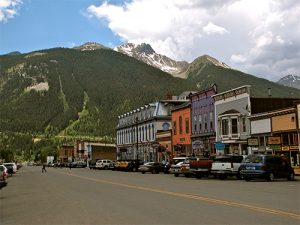
(Wikimedia Commons)
Silverton is also a destination for the Durango & Silverton Narrow Gauge Railroad train, an authentic steam-powered, coal-fired, scenic railroad, which departs from the city of Durango to the south. The route was established in 1881. The train service to Silverton runs May through October. It is the last narrow gauge steam railroad still operating in the area, where a number of trains connected several of the area’s mining camps in the late 1800s.
Silverton is part of the San Juan Skyway, one of the most scenic drives in America. The Million Dollar Highway, as it is known, connects the historic mining areas of Silverton and Ouray. Driving along the Uncompahgre River, at elevations from 6,200 near Cortez to 11,008 feet at Red Pass Mountain, the traveler is rewarded with breathtaking scenery of deep gorges, mountain lakes, and dense stands of evergreen trees. I can vividly remember the steep, winding road down to Ouray, with a 25-mile-per-hour speed limit!
Early Deposits
Deposits of gold and silver were discovered along the Animas River in 1860, when Charles Baker and several other prospectors searched for the precious metals. Because of the Civil War, the prospectors did not return to the area until the early 1870s. The fact that the discoveries were on Ute Indian land did not stop more than 1,000 prospectors who headed to the area.
After negotiations with the Ute Indians, the town of Silverton was created in 1874 over the area known as Baker’s Park, and within a year its population had doubled. Like many other frontier towns of the West, Silverton had many saloons, dance halls, and hotels and a red-light district known as Notorious Blair Street, full of gamblers and prostitutes. These were counter-balanced by the law-abiding citizens, homes, schools and churches.
Twenty-three miles north of Silverton is the town of Ouray. It is the Ouray County seat and has a population of about 1,000. Gold veins were discovered there in 1877, and at its height, the area boasted 30 active mines. The Camp Bird mine, established by Thomas Walsh in 1896, was the largest in the area. The town was incorporated in 1876 under the name of Ouray, after Chief Ouray of the Ute tribe. Here, too, most of the buildings date back to the late 19th century, and the entire Main Street is registered as a National Historic District.
There are several museums and mining attractions in the Silverton-Ouray area that you may want to visit. In Silverton, the Old Hundred Gold Mine offers a tour with a train ride that runs a third of a mile deep inside the Galena Mountain (www.minetour.com). Also in Silverton, the Mayflower Gold Mill tour is available for self-guided tours.
Around Ouray
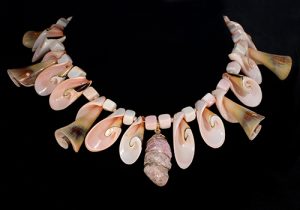
In Ouray, the Ouray County Historical Society (OCHS) Museum (www.ouraycountyhistoricalsociety.org) exhibits the history of this mountainous community. The museum is housed in the original St. Joseph’s Miners’ Hospital, built in 1887 and operated until 1967. Several books about the history of the area can be purchased through the museum’s Web site using the Book Order Form.
At the Bachelor Syracuse mine in Ouray, you can take a tour 1,500 feet deep into Gold Hill. You can also learn gold panning, visit the original blacksmith shop, and pick up some supplies and souvenirs at their gift shop. When we visited the mine years ago, we had a wonderful time and learned a lot about the rich ore veins and the local mining history.
For up-to-date travel information, visit the Silverton Chamber of Commerce at www.silvertonchamber.org and the Ouray Chamber of Commerce at www.ouraycolorado.com.
The Source of Astorite
The Toltec mine was originally owned by Colonel John Jacob Astor IV, one of the wealthiest men in early 20th-century America, who owned several gold and silver mines in the Silverton mining district.
Astor was born in 1864, in Rhinebeck, New York. A member of the prominent Astor family, he was an American businessman, inventor and writer. He served as lieutenant colonel during the Spanish-American War of 1898. His 1894 science fiction novel A Journey in Other Worlds: A Romance of the Future was a commercial success. Astor was a real-estate magnate and became famous for building the luxurious 17-story Astoria Hotel in New York City in 1897. It adjoined the 13-story Waldorf Hotel, which was owned by his cousin William Waldorf Astor.
The combined historic landmark properties, known as the Waldorf-Astoria, became a prestigious destination for traveling visitors.
After his first marriage ended in divorce in 1909—a scandal back then—at the age of 47, Astor married 18-year old Madeleine Talmage Force. The couple went on a long honeymoon in Europe and Egypt, and because Madeleine became pregnant, they were returning home aboard the RMS Titanic on that fateful maiden voyage in 1912. The Astors were the wealthiest people on board. Just before the ship sunk, Astor helped his wife, her maid, and her nurse get into a lifeboat, but although he asked to accompany his wife because she was in a “delicate condition”, he was not allowed to embark. He died when the ship sank. Their photos were on the covers of newspapers that reported the tragic accident. This heartbreaking story has added a layer of history, lore and mystique to Astorite.
After Astor’s death, the portal of the Toltec mine was sealed by dynamiting the entrance. It would not be reopened until 2001, when Will Benham, an enthusiastic rockhound from Tucson, acquired the patented mining claims through a bid to the United Bank of Denver. Since 2003, the mine has been owned by Keith and Connie McFarland of K&C Traders in Silverton (Brendan Laurs, Gems & Gemology, Summer 2007). I recently tried to contact them and check on the mine status, but I was not successful.
Mystical Traits
Based on its composition, astorite is a somewhat familiar and somewhat mystical gem
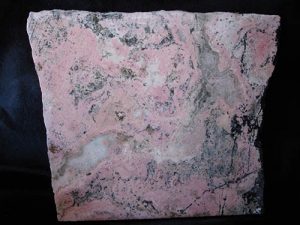
material. At first glance, it looks like light-pink rhodonite, but upon closer examination, we see that there is a lot more going on.
Rhodonite is a major component of astorite. It is a manganese inosilicate, (Mn2+,Fe2+,Mg,Ca)SiO3, and a member of the pyroxenoid group of minerals, crystallizing in the triclinic system. It is more commonly found in massive form than distinct crystals.
What makes the rhodonite-rich astorite an exceptional material, is the addition of three more major components:
• Rhodochrosite, a manganese carbonate mineral (MnCO3), with an intense rose-red color and a Mohs hardness around 3.5-4;
• Quartz, in the form of pseudomorphs, chalcedony, and small druzy pockets, all of which bring the hardness up; and
• Ore gangue, which is a highly silicified, complex sulfide with native metallic elements of gold, silver, copper, lead, chalcopyrite and magnetite, as well as galena, tennantite and tetrahedrite, all of which contribute to its rarity.
The term “ore gangue” refers to material that surrounds or is mixed together with a main mineral or ore deposit and is commercially worthless. Gangue is usually separated from the ore mineral through the method known as “mineral processing”. Gangue minerals were often dumped out as tailings.
It is possible that Astorite may have fallen into that category, as the rock was not considered gold or silver ore, although it does assay at about 0.1 ounce of gold and 7.75 ounces of silver per ton.
Minor Minerals With Appeal
There are also some rare mineral inclusions of yellow helvite, rose-red crystals of friedelite, and transparent, colorless fluorite and calcite. The amount of these minor minerals varies in each piece of rough and, consequently, in the cut slabs.
These additional mineral inclusions make Astorite a unique lapidary material with an attractive color combination of soft pink, grey, black veins, and tan spots, and beautiful, translucent lacey and fortification patterns, or plumes of white chalcedony. The material is also highly fluorescent under both shortwave and long-wave ultraviolet (UV) light.
Many mineral skeptics still argue that the material is simply rhodonite, but Raman spectroscopy performed on two cabochons at the Gemological Institute of America (GIA) lab in Carlsbad, California, proved that the rock is composed of rhodonite, quartz, rhodochrosite, and other minerals. More importantly, it also showed that the black spots are composed of chalcocite, galena, pyrite and sphalerite (Brendan Laurs, Gems & Gemology, Summer 2007), unlike the black manganese veins that run through rhodonite (“Astorite: A distinctive new gem material”, J.R. Yakabowski, Wire Artist Jeweller, Vol. 6, No. 6, 2003). Astorite has its own listing at http://mindat.org/min-32145.html.
My husband and I first purchased some rough Astorite from Will Benham in 2002. I am thankful to him for also providing us with the mineral data of this material.
We immediately recognized the beauty of the stone and eventually realized that the layers of history and lore behind it would help Astorite become a desirable gemstone. We visited the historic towns of Ouray and Silverton in 1994, but at the time the mine had not reopened and there was no such material on the local market. However, during that trip, we purchased a slab of the more “common” rhodonite from the Sunnyside mine dump, at Bonita Peak in Gladstone, which we could now visually compare to Astorite slabs.
At present, rough material and slabs of Astorite are seldom sold, and are considered very rare.
Lapidary Uses
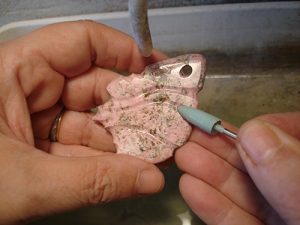
Astorite is “used for carvings and cut into cabochons of various size and shapes for jewelry” (Rare Gemstones, by Renée Newman, International Jewelry Publications, 2012). I am very thankful that one of my carvings was chosen for the Astorite section of Rare Gemstones.
The hardness of Astorite is 6.5-7 on the Mohs scale, depending on the amount of chalcedony quartz present. The addition of chalcedony veins brings up the hardness of this lapidary material considerably from that of plain rhodonite, which is 5.5-6.5. When slabbed, Astorite holds together well. Even thin slabs retain good sectional integrity. It is also possible to reveal beautiful, matched stone images in consecutively cut slabs, such as the two “love birds” that appeared when we slabbed a piece of the material.
Astorite is easy to cut into cabs and free forms or to carve. You can start coarse grinding with 100 grit diamond, which will help remove unwanted material quickly, then continue fine grinding with 220 grit. After that, follow the traditional sequences of sanding at 280, 600, 1,200 and 3,000 grits. For materials with mixed hardnesses, it is best to spend sufficient time at the 1,200 and 3,000 grit steps to remove all scratches and dimples. It is even better to complete an 8,000 grit step, which facilitates a better and higher polish, before continuing to 14,000 and then 50,000 grit diamond for a final polish.
One drawback when cutting this material is the dirty mess that the black inclusions, as well as the included silver, create in the pan, but the final, beautiful result overshadows this minor problem.
It is preferable to start with slabs of Astorite that display a balanced combination of soft pink, black veins, striking, lacey patterns of white chalcedony, small druzy quartz vugs, and “wires” or tendrils of gold and silver. All of these natural hallmarks offer a great palette to the lapidary, and I usually choose to spotlight them. Choose templates in your favorite shapes and slide them over a slab until you find the best focal point and composition, or simply draw your design on the slab freehand.
Pure Patterns Sought
When creating jewelry, Astorite is a wonderful canvas on which to create unique pieces. The distinctive, swirly, “strawberry ice cream” patterns of Astorite, along with the “steely” look of the chalcedony veins, may inspire fresh color combinations. A combination of white, pink and silver pearls, for instance, may be a great addition. I particularly love the freshwater cultured pearls, which have a beautiful range of soft metallic colors.
These pearls, which are not enhanced in any way, are the latest fashion trend in the pearl
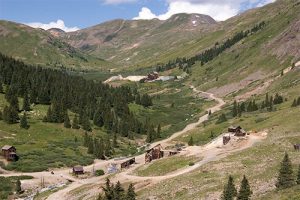
(Wikimedia Commons)
industry and are in great demand. Customers respond very well to the fact that these pearls have not been dyed or bleached, as are most cultured pearls today.
In one of my necklaces, I also used multicolor moonstone beads, ranging from colorless to peach, which matched the chalcedony veins well.
You may want to stay in the pastel color scheme of white-pink-silver, or you might create a more striking combination with gemstones like black onyx or with black pearls.
Pink gemstones get mixed reviews from the public, and it may be somewhat difficult to sell pink gemstone jewelry; to some, pink stones may be considered too sweet and cute, while others find them adorable and charming. The delicate, pastel pink color mixed with grey and black veins, and gold and silver flecks woven in the material’s structure, makes Astorite gemstones beautiful, distinctive, and eye-catching.
Share the gemstone’s unique story, its mining history, lore and rarity with your customers and collectors, and they might consider your Astorite jewelry a desired treasure.



